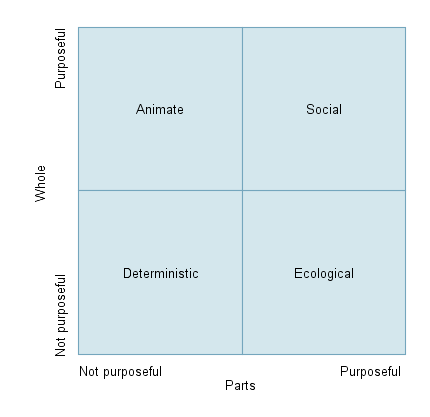Deterministic vs. Animate vs. Ecological vs. Social Systems
In systems thinking, a system is a set of interrelated and interacting elements that make a unified whole.
One of the greatest management thinkers and an expert in systems theory, Russell L. Ackoff, in his book, Re-Creating the Corporation, proposed an interesting typology of systems that depends on whether or not the parts of a system and the system as a whole are purposeful
.
- Both a deterministic system and its parts are not purposeful.
- An animate system is purposeful, but none of its part are.
- An ecological system has no purpose, but some of its parts have purposes of their own.
- Both a social system and at least one of its parts are purposeful.

You can read more about these types of systems in an even more entertaining Ackoff's book, Differences That Make a Difference.
Key Points
UOA creates digital constructs that provide interactional and operational support to organizational units. An organizational unit is a social system, which represents a social technology phenomenon programmed to some purpose(s).
UOA views the organization as an implementation of the Composite design pattern with every node treated either as a Composite (control unit) or a Leaf (functional unit).
Unit software must be as comfortable to an organizational unit as a house is to a family, a space station to an astronaut crew, or a battle tank to a fighting crew.
Each unit must have a formal [software] boundary, which represents a contract between the unit and other entities inside and outside of the organization.
Each unit runs its own operations implemented as executable business processes. Every process in the organization is owned by exactly one unit. A unit might engage another unit or organization to perform a task within the context of the process it owns.
UOA places a special emphasis on control units, which today often consist of just one or a few people, have inadequate information support, and, therefore, have become the weakest links in modern organizations.
UOA uses Systems Thinking for defining the problem, Organization Design for configuring both an enterprise and a composite unit, SOA for constructing unit boundaries, EDA for inter-unit communication, BPM for defining unit operations, and Business Rules for governance.